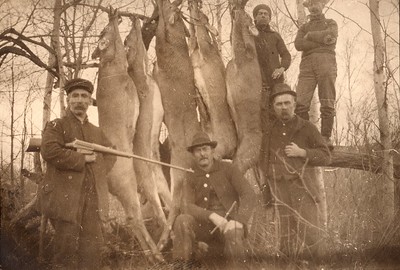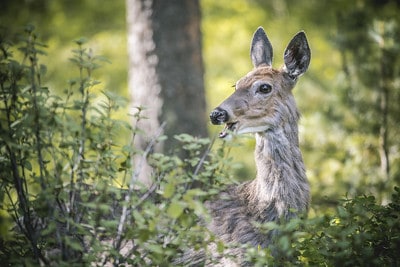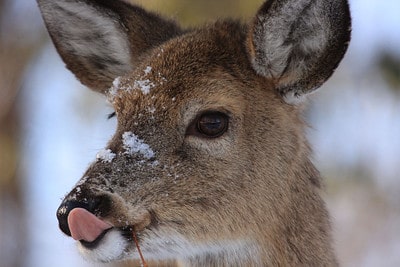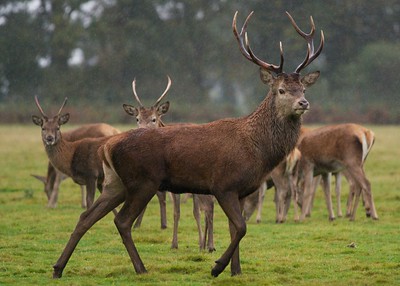At some point, every deer hunter buys or considers buying deer scents and giving them a try. Commercial scent makers have realized this and turned the three primary scents (food derivatives, sexual lures, and cover scents) into hundreds of products.
In nature, a deer can detect the smell of food, a potential mate, and two and four-legged dangers. But have manufacturers truly bottled these aromas, and are the promises on the sprays, wipes, and roll-ons true?

To be honest, the jury is still out on sexual lures (urines). Despite the existence of a hundred-million-dollar scent industry, no independent research has been done on their effectiveness. We have companies who call themselves labs, hunting celebrities endorsing their use, and anecdotal evidence of our own. We do not have scientific proof that a $19.99 product will defeat a deer’s nose.
So I won’t be providing any links to urine products and no recommendations regarding specific products to use.

Related: Four deer hunting mistakes.
Deer scents: Urine/sexual lures.
The first thing you must understand about “real” deer urine is that it all comes from captive deer. These donators are raised in pens with screen floors and more than urine drops through the grates. At best, a manufacturer can only brag about its ”freshness” (how many days it took to go from the pen floor to the bottle you’re holding in your hand).
Synthetic urine uses chemical compounds that simulate some of those found in actual deer urine. Manufacturers of synthetic urine claim their product is more effective and travels further. One undisputed benefit is that it cannot spread CWD as natural urines can.
Both natural and synthetic urine come as either doe or buck urine.
Doe urine.
Doe urine is believed to both lure bucks, and calm does. It also can cause an increase in deer curiosity over an area in which the urine is applied. Doe urine is often used early in the season before buck bachelor groups have broken up and the rut has begun.
Buck urine.
Buck urine makes a local buck believe his territory is under threat. If your stand is near a scrape and you are hunting before the rut, grunting will bring an angry buck near, and the urine will confirm his suspicions.
Before you run off and spend $10 an ounce on a bottle of pee, consider what Fred Trost, former host of Michigan Outdoors, did. He poured ammonia, Aqua Velva, and his urine on different spots and showed deer visited each site as often as those with bottled deer urine applied to them.
Mock deer scrapes made using deer urine.
A deer scrape is a way for bucks to communicate scent. A buck creates a scrape by rubbing his nasal, orbital, and forehead glands on a branch that hangs above his head. It then paws (scrapes) the ground under the branch clear and urinates over the tarsal glands on the inside of its legs.
Deer hunters create mock scrapes by scouting for chest-high branches and then scraping the ground below it clear. These hunters then apply deer urine to the cleared land and the branch.
The best time to create a mock scrape is just about anytime before hunting season. Bucks have been observed at scrapes from the summer and right up until breeding season begins—when these visits cease. In most areas, creating a mock scrape after deer season has already started is more likely to scare off a buck than attract one.

Related: Three best deer hunting calibers.
Deer scents: Food derivatives.
There is no disputing the effectiveness of using a food scent to lure deer. Drop a bag of Acorn Rage on a deer trail, and they will eat it within a day. However, continue to provide free food for longer than a week—and they will become nocturnal.
Deer food scents (rather than bait) like Apple Bomb not only draw deer into your stand, it’s strong enough to make them ignore your smell. And deer scents alone are not considered bait and therefore allowed in all states.
Deer scents have one flaw, they must be used at least twice an hour to provide a steady beacon for the deer to follow. Deer scents should be applied to the soles of your boots when you are 50-100m from your stand. Do not respray the product until you reach your hunting stand, then spray it and the area around it.
Deer corn, a cheap way to take one deer and kill a few others.
Feeding deer corn is illegal in some states, and for a good reason. During the regular deer hunting season, a deer’s body prepares for winter. It now relies on energy conservation, fat reserves, and a diet of woody vegetation to survive until spring.
In other words, no carbohydrates. So when deer stumble upon a 50-pound pile of corn, coated or soaked with some sweetener, their systems cannot digest the massive amounts of corn they eat.
Have you ever gutted a deer and found its belly full of undigested corn? It may be your neighbor is baiting them, but it could be something they ate three days ago. Either way, chances are good other deer around you are already dying with their bellies filled with worthless corn.
Worthless is probably a poor word choice. Some of the ”deer corn” on the market today, supposedly made for deer to eat, can go for ten times the price of regular feed corn. Regardless of how much you paid for it, feeding deer corn in winter is a death sentence.

Related: Where to shoot a deer.
Deer scents: Cover sprays and odor reducing products.
Two types of products offered for sale contend they can defeat a deer’s radar-like nose: Cover scents (food lures, skunk essence) and odor-reducing products (antiperspirants, body washes, and scent-killing sprays).
Odor reducing products.
The odor-reducing products maintain that they can eliminate your human scent. All you have to do is shower and shampoo with their soaps, wash your clothes in their detergents, dry your clothes with their dryer sheets, and then douse yourself, your gear, and your boots with their sprays. Presto! You are invisible to the nose of a whitetail.
You will hate me if you are already a firm believer and constantly using these products. At best, they merely send you out into the predawn darkness with a false sense of confidence. At worst, they send you with a lot of remaining human-caused scents.
Either way, if you think you can’t be detected, throw caution to the wind. But you are supposed to be playing the wind, not flirting with it. The fact is you are shedding, sweating, and exhausting human scent with every step you take.
You sweat, you burp, you fart, and you scrape skin cells off your body every time you scratch an itch. Just exhaling sends a plume of invisible carbon dioxide into the air and directly downwind of you. Heck, you might as well light a human-scented candle.
But I’m just wasting my time and shouting into the wind—I’ll never win this argument. I do not even know a single hunter who doesn’t have a shelf dedicated to these products. So feel free to buy that Nose Jammer Natural Hunting Scent Eliminator Deer Scent Blocker Best Value Combination 4-Pack Kit (Field Spray, Deodorant, Wipes, Shampoo/Body Wash) from Amazon and forget I even mentioned it.

Cover scents.
Cover scents like Tink’s Acorn Spray have an entirely different purpose for being used. The idea is to flood the deer’s nose with a lovely scent that buys you time. Buys time because your stink is still noticeable, but the deer’s attention to it is distracted.
Cover scents are to deer hunting what a magician’s hand movements are to a magic trick, a time-buying diversion—hopefully, just enough time to squeeze the trigger or finger the release.
I did mention skunk, didn’t I? Well, my best advice is don’t put it on you or your gear. Spray it around your blind, put it in a baggie, and hope nothing leaks on the way home. Sure, skunk essence works; deer even seem to like it. But use it sparingly, or your clothes will soak up the smell, and your stand might be an unbearable place to sit for very long.
Deer scents: Pricier than myrrh, less effective than aftershave.
To wrap things up, urine’s effectiveness has never been scientifically proven. Even a mock scrape may just be attractive because of the smell of the disturbed soil.
Food scents, on the other hand, work like a charm. Just stick to using scents only, and use them only while hunting.
Cover scents are better than odor killers for two reasons, they are cheaper and work (to a certain degree).
Look, it’s your money. If you have a lot of it and trust scent manufacturers, you might want to buy this Scent Covering Gum. Some bowhunters swear by it.

